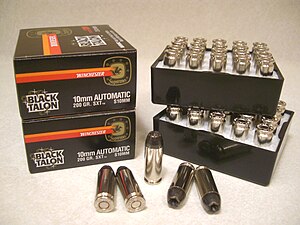Black Talon
| Black Talon | |
|---|---|

10mm Black Talon ammunition
|
Black Talon is a brand of hollow-point pistol and rifle ammunition introduced in 1991 by Winchester, primarily intended for law enforcement and personal defense use. Black Talon rounds were known for the unique construction of the bullet and its sharp petal shape after expansion following impact with tissue or other wet media. Black Talon ammunition was produced in the following calibers: 9mm Luger, 10mm Auto, .40 S&W, .45 ACP, .357 Magnum, .44 Magnum, .300 Winchester Magnum, .308 Winchester, .338 Winchester Magnum, and .30-06 Springfield.
The Black Talon handgun bullet is a jacketed hollow-point bullet with perforations designed to expose sharp edges upon expansion. The bullet included a Lubalox coating, a proprietary oxide process. Though widely misreported to be Teflon, molybdenum disulfide, or wax, the ammo has an unusual black appearance compared to other copper-jacketed or lead bullets. The black appearance was due to the oxidized copper jacket. This Lubalox coating was to protect the barrel rifling, and did not give the bullet armor-piercing capabilities. This coating is still widely used on many of Winchester's rifle bullets today.
The bullet was designed in 1991 under the supervision of Alan Corzine, who at that time was VP of research and development for Winchester. The round quickly developed a reputation as a very effective expanding bullet. The alleged armor-piercing (AP) notion is urban legend, and was a result of media hyperbole (perhaps confusing "Talon" with the "Teflon" that coated KTW AP bullets)—rather than test or field data from actual shootings considering the short time it was on the market. Col Leonard J. Supenski of the Baltimore County police department said "It has the stopping power that police officers need and it is less likely to ricochet or go through the bad guy," something that could be said of any reliably expanding hollow-point. Despite its unique design, the Black Talon was found to be comparable in performance to conventional hollow-points.
...
Wikipedia
